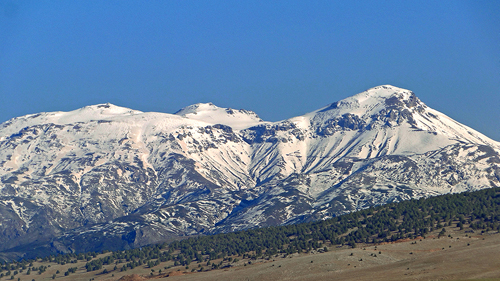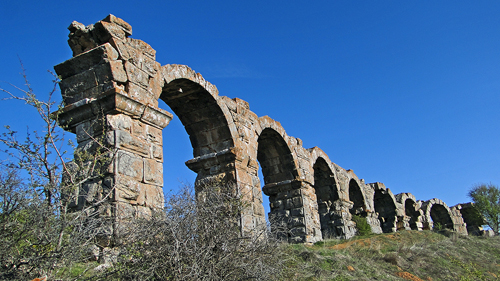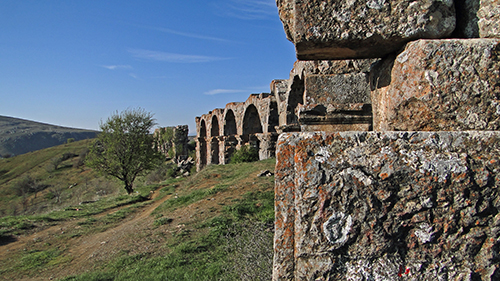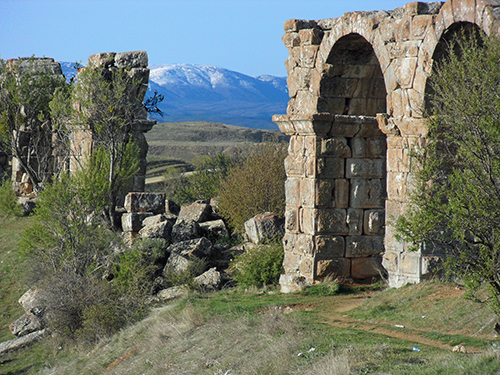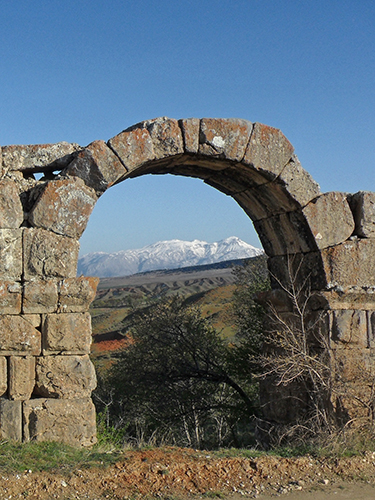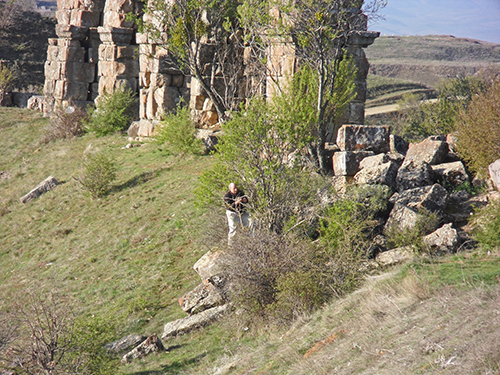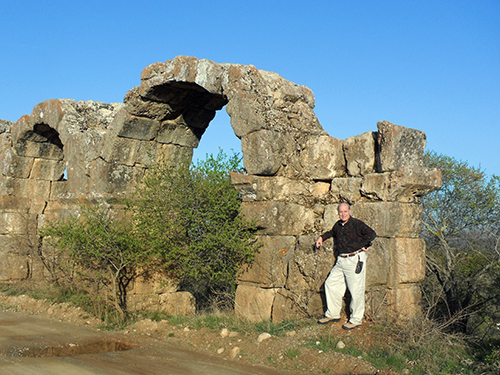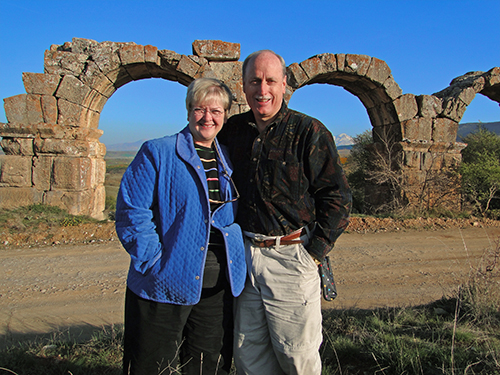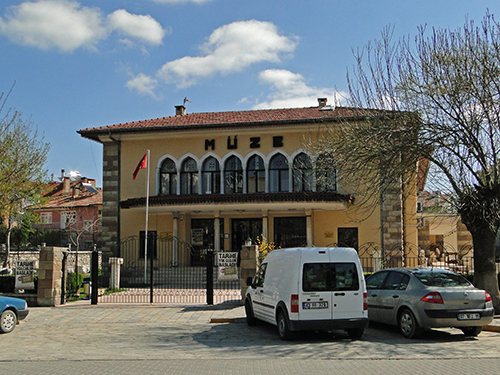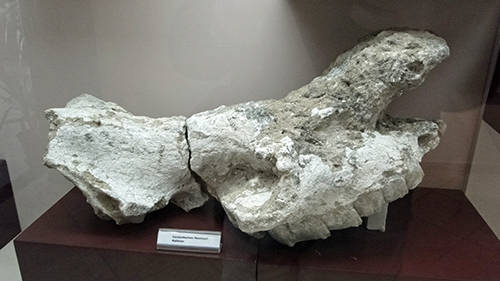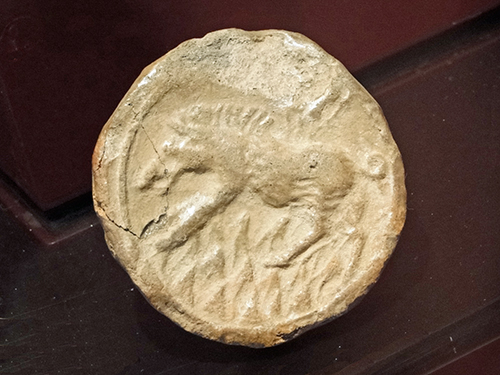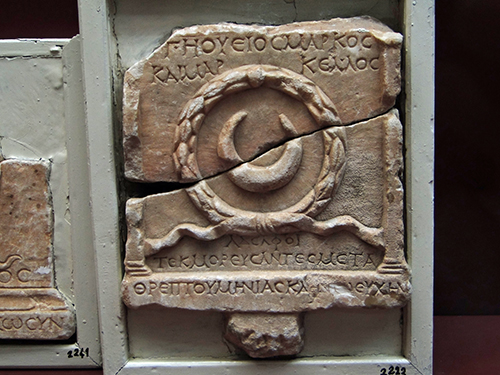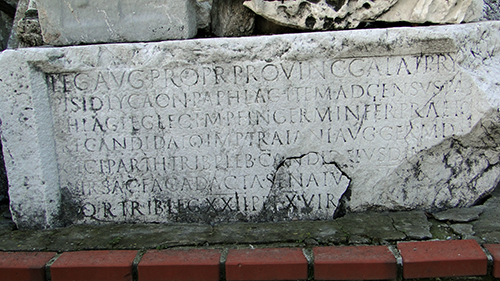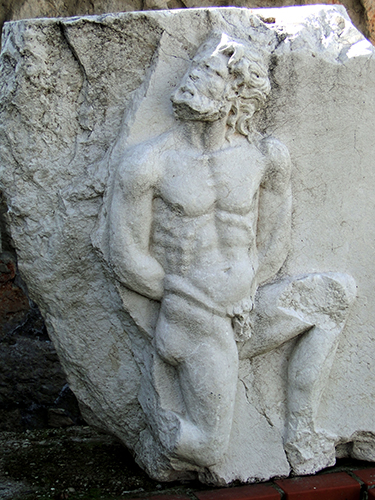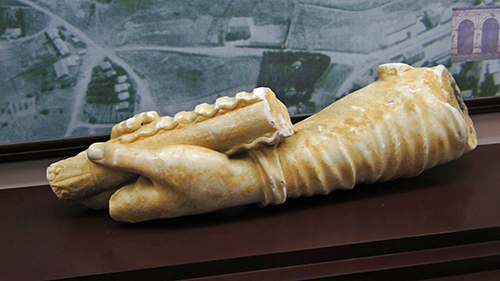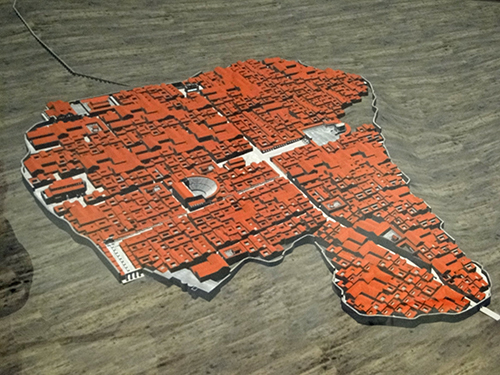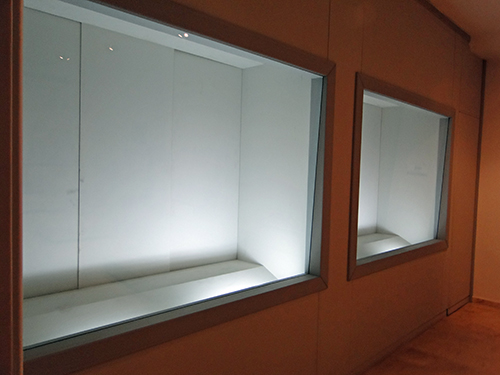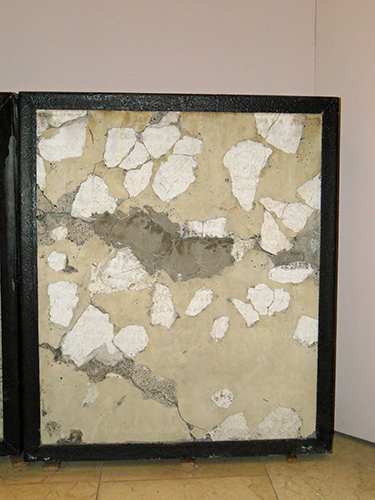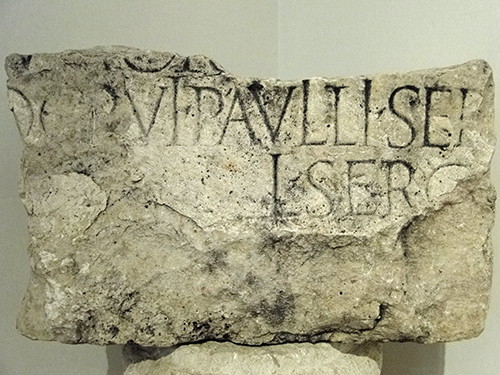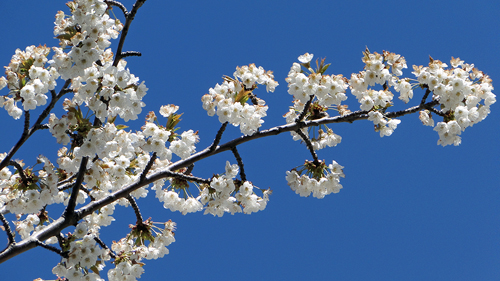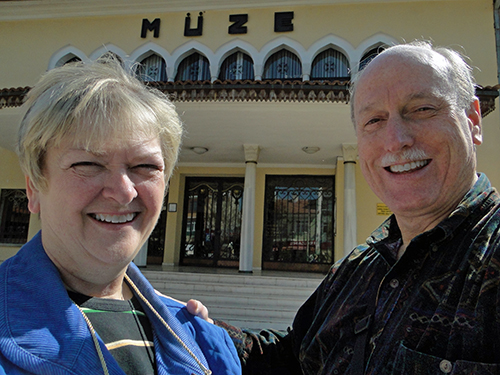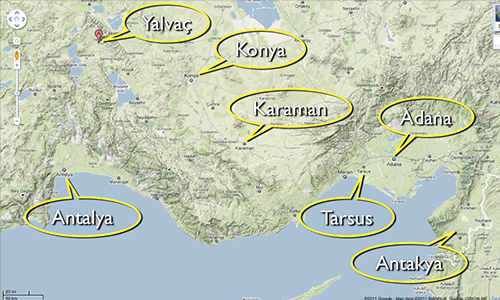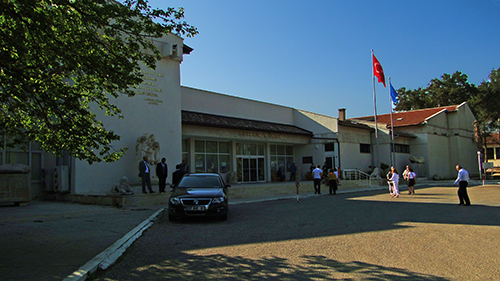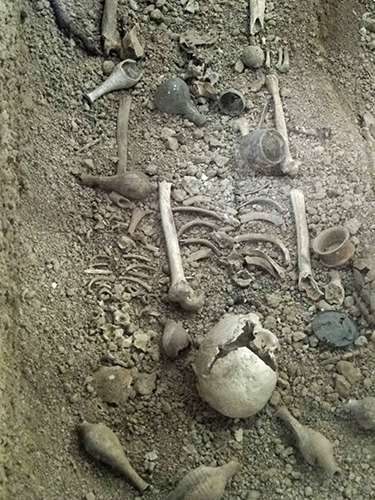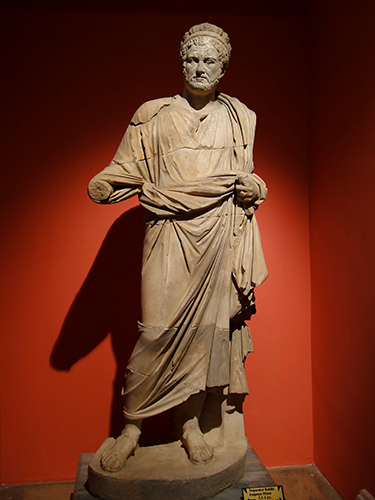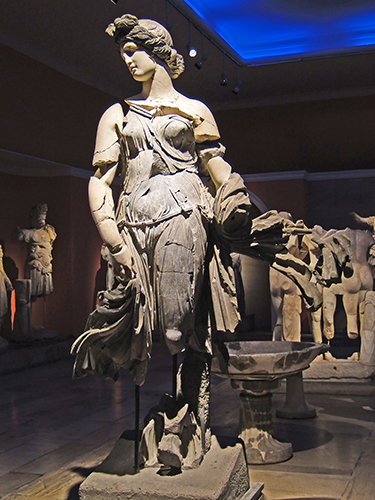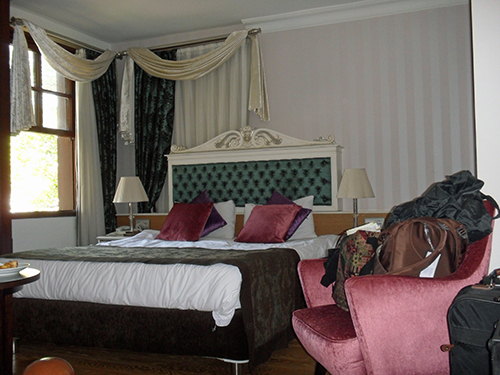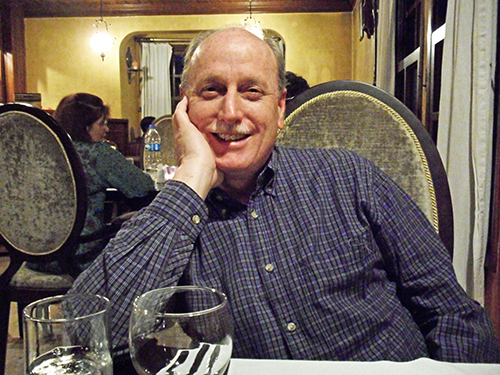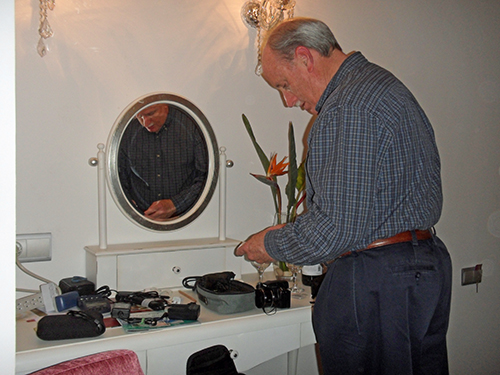Yalvaç. Up at 5:45 am to get ready and pack. We learn that breakfast is not until 8 am, so we vamp our plans and go riding around the fairly large city of Yalvaç to find the location of the Müze (museum) and to see if we could find the Roman aqueducts, which we saw not far from the Antioch site, but we had no signs or maps about how we might get to them. The front that had brought us rain for several days in Lystra (Karaman) and Konya (Iconium) finally was clearing out by the time we got to Yalvaç (Antioch of Pisidia), so we started having better weather by the time we were touring the site of Antioch of Pisidia yesterday afternoon, and this morning we have absolutely superb weather. On the way through town, we see the Müze (museum) building, so now we know where this building is for our visit later in the morning. The market that had kept us from our hotel when we arrived yesterday is all gone today, so getting around is easy. We found out that we had arrived on Market Day yesterday.
Antioch Aqueducts. We find the dirt road next to Antioch of Pisidia and follow this road, because Jerry has a strong suspicion this road might lead out to the aqueducts. Yea! He was right. What a radar he has, and what a great find. The aqueducts are in fairly good shape. First-century Roman aqueducts are amazing structures. We stay a while and take photos in the wonderful morning sun. Majestic, snow-capped mountains are in the distance, a beautiful vista against the bright, blue sky.
Jerry went down the hill to take a movie and had me stand near the aqueduct for perspective. While he was filming, unknown to him, two wild dogs started running up from far behind him, charging toward him. He was oblivious to their threat, so intent was he on making his video. I did not want to interrupt his action shot as he was narrating his movie and walking toward me, but I was afraid to death of the threat unknown to him of the wild dogs coming at him. I decided not to disturb his filming, but to let him walk past me. As soon as he passed me with the camera, I did what one might call the “Zhivago move.” In the movie “Dr. Zhivago,” With an assertive wave of his arms, Yuri chased off the howling wolves one night that were frightening Laura. So, taking my cue from the movie, I made a stand between the charging dogs and Jerry and waved my arms with as much assertive authority as I could muster without making a sound—and the wild dogs immediately stopped dead in their tracks and turned and ran away! Whew! Jerry never knew of the danger he was in until I told him later. He was pretty astounded all that took place while he calmly was walking along the aqueducts making his movie. One thinks of the lyrics, “His eye is on the sparrow, and I know He watches me.” Uncanny that Jerry had taken pictures of sparrows soaking up the morning sun on the top of the arches of the aqueducts.
We finished up at the aqueducts and headed back to the hotel. We enjoyed a late breakfast of soft boiled eggs, tomatoes, cucumbers, and hot bread. Now, we ‘re off to the Müze we had spotted earlier.
Yalvaç Müze. The Yalvaç Museum has one of the nicest museum building entrances we have seen, with a pretty architectural front and manicured grounds. When we arrived, the same man from the Antioch archeological site yesterday that showed us the way to our hotel was at the front desk! He’s a pleasant fellow and asks if we slept well. He unlocked the museum for us, and again, we are the only ones in the museum. We then toured the museum inside.
The museum had interesting holdings, starting off with the jawbone of a Late Myocene mammal found in one of the valleys near Yalvaç. Jerry was interested in a seal with the image of a horse from the Bronze Age (about 3rd cent. B.C.). Several inscriptions derive from a temple of the god Men. An inscription mentioning the province of Galatia also caught Jerry’s attention, as well as a relief of a naked (= conquered) Galatian, hands tied behind his back and a rope around his neck, imitative of the style of the famous reliefs depicting Julius Caesar’s conquest of Gaul. Delicate gold-work is seen in an intricate gold vase about 2 inches high from the Roman period. A marble arm with a scroll in the hand illustrates the scroll form of books and writing. An overhead picture of a model of the ancient city of Antioch of Pisidia Jerry found most instructive for visualizing the ancient city’s layout and buildings.
One of the most fascinating pieces to Jerry was the head of a fisherman of the 1st century A.D. Since the disciples of Jesus were fishermen, Jerry’s curiosity naturally was peaked. The head was displayed in a case allowing a 360 degree inspection. Jerry studied this piece for quite some time but could not determine how the fisherman vocation could be ascertained from the features of the head. He then decided that the fisherman aspect must have been a part of the rest of the sculpture, if that survived, or something related to its discovery “in situ,” that is, in its original location.
Jerry was greatly disappointed to find that the Paul room of the museum was under renovation, so almost everything was missing (in storage we guess). The display cases were completely empty, and empty pedestals spoke of missing statuary. Jerry was so disappointed because he was certain he was going to derive a number of illustrations for his classroom from this area of the museum. However, one has to get used to unforeseen circumstances when traveling abroad and especially when dealing with museums.
Even if the Paul room was pretty much empty, the museum still had other treasures of interest to my scholar. For one, Jerry was excited to see a rare copy of the Res Gestae Divi Augusti (“The Accomplishments of the Divine Augustus”), a summary of highlights of Emperor Augustus’s career written by Augustus himself.
In addition, Jerry also was glad to get to view the Pauli inscription of an L. Sergius Paulus, discovered at Pisidian Antioch in 1912. This person possibly could be from the same Pauli family as the proconsul of the same name, Sergius Paulus, whom Paul encountered and converted on the island of Cyprus on the first missionary journey.
We then toured the garden area outside in the neatly manicured yard of the museum. The yard displays statuary and inscriptions in an orderly fashion. A pretty blooming tree in the garden has bees buzzing all around its white blooms.
We need more TL (Turkish Lira). Luckily, there’s an ATM right across the street from the museum, so I am able to get more cash easily. Now, off to find a gas station with a car wash, because this car is now extremely muddy! We stopped at a Shell station on the edge of town and filled up, only to find out that the car wash does not work. Ugh. So, we and our muddy car get on a road headed south that will take us to D330, the main north/south highway down to Antalya on the southern coast of Turkey via Isparta. We’ll have to find a car wash in Antalya.
Mountain Driving. The drive down to Antalya was a long and hard trek of hours and hours through mountain pass after mountain pass. The inclines were steep, the altitudes dizzying, and the roads full of switchbacks to make the ascents and descents. Jerry is a real trouper. He has been driving these Turkish roads for days on end, fighting the congested traffic in cities and the caravans of trucks of all kinds on the highways that always need passing. He seems to be like the Energizer Bunny. He just keeps going and going and going.
We went through a very pretty village named Egidie located on a lake, which appears to be very much a resort town. Tulips are being planted in the median in preparation for the tourist season. The town is quite quaint and scenic. Wish we could have enjoyed Egidie’s view for a while, but we have to push on through the mountains with their unending switchbacks up and down. Tough drive.
Antalya (Attalia). Finally! After hours on the road, we arrive in Antalya but can’t find our hotel. The traffic is the worst we’ve encountered for congestion and confusion in this city of ¾ of a million people. Streets are not named, not even the major ones. However, we do see signs to the museum we intend to visit while here, so we decide to go to the museum first and then look for our hotel later.
Antalya Müze. The Antalya Museum has a nice, paved parking lot. Unfortunately, the curbs are about a foot high. This high curb spelled disaster for Jerry. As he pulled into a parking spot, we got the front bumper hung on the curb! Naturally, Jerry backed up the car immediately to get the bumper off the curb. The front bumper, however, just hung on the curb and was torn partly off the car! Yuck! Jerry inspects the damage, but we decide to deal with the problem later, not wanting to miss getting into the museum. So, we go on into the museum and purchase our tickets. We got a sandwich in the little café before touring the museum.
The Antalya museum is spectacular. I can see why this particular museum has won so many awards. While the museum has holdings that go back millions of years, such as a petrified Echinodematas, Jerry’s interest was Greco-Roman. To give you just a sampling of what we saw, let me detail what you will be seeing in the pictures below.
An exquisite vase from the classical Greek period is representative of an entire collection of beautiful Greek items. The theatrical display included interesting copies of theater masks. The museum has numerous statuary, busts, friezes, and engravings. One impressive statue on a monumental scale was of Alexander the Great. Friezes of sacrificial bulls led into the Perge theater, as well as friezes illustrating the story of Poseidon, certainly appropriate, since Perge was an upriver port close to the Mediterranean coastline. An impressive frieze of Roman military horses arrayed in parade style came from the cenotaph of the emperor Gaius Caesar. Social life was illustrated in the markings of the top of a stone game table that included nearby an illustration of a Greek vase in which two Greek soldiers are engrossed in playing a game. The coin collection illustrated well the Hellenistic period of Jewish history, especially the rulers of the Syrian throne leading up to and after the Jewish revolt under the Maccabeans. As stated, many periods were covered, including a well-preserved burial from the Early Bronze Age along with the unusual burial chambers that were found in Patara. The Patara burial skeletons were displayed under glass that you could walk over. Very interesting indeed. Another find from Perge is an extensive collection of artistic Roman glassware. Jerry had a keen interest in a statue of a Roman priest of the imperial cultus. The collection of monumental sarcophagi is the best we will see anywhere on our trip, with the lone exception of the Alexander sarcophagus in the Istanbul Archeology Museum. A picture of Jean taking notes while standing behind just the lid of one of these burial chambers illustrates their huge proportions.



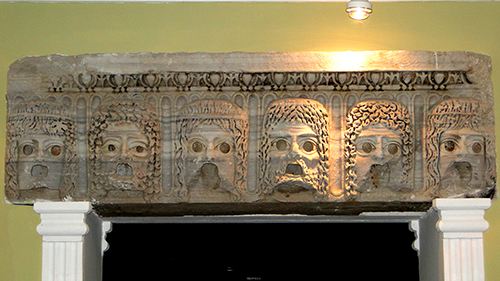
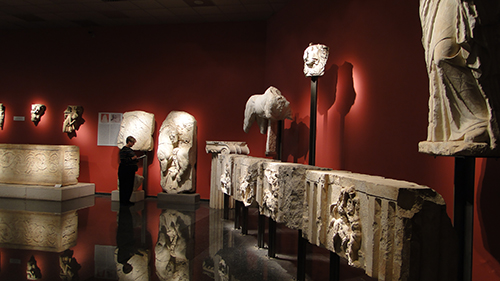

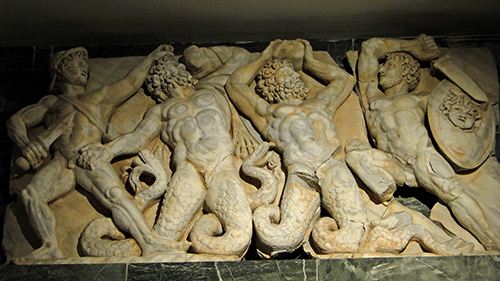

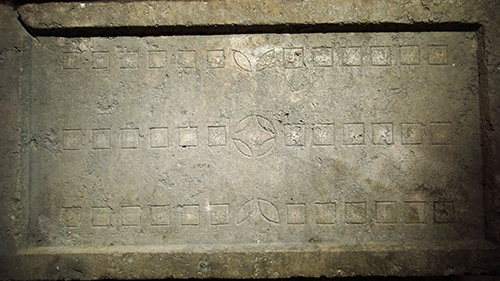
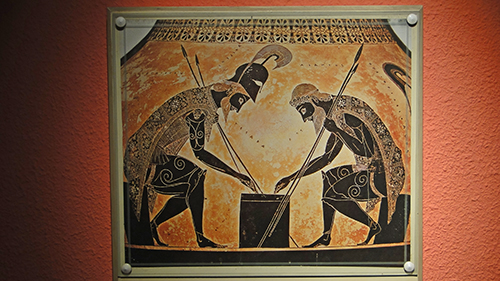
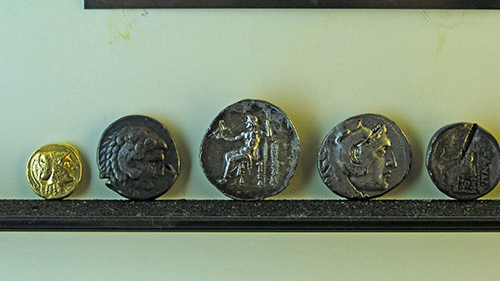
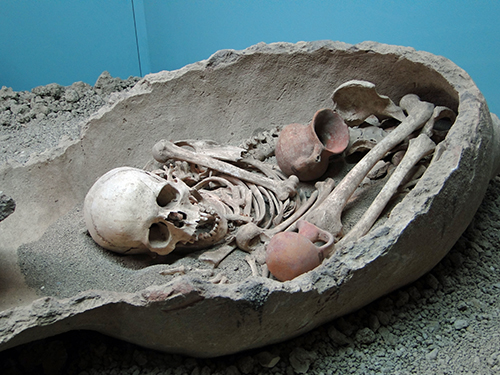
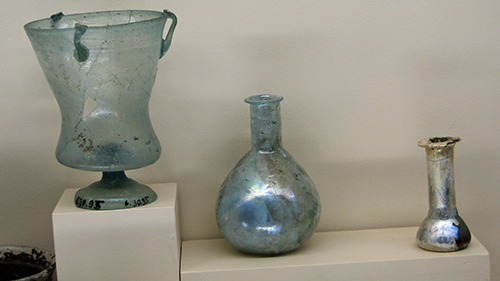
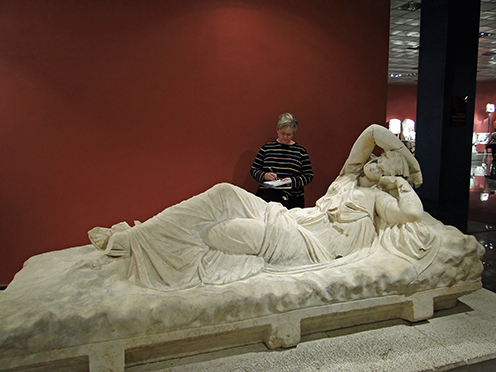
Of all that we saw in this fabulous Antalya Museum, however, the “Dancer” sculpture hands down was our favorite work of art. This fabulous piece is a beautiful bronze statue that is so life-like that you almost can feel the wind blowing her light garments as she dances. The workmanship is extraordinary for the graceful lilt of the female form, the informal hair arrangement in loose, braided rolls on either side of the head, the soft, rounded facial features leading into a strong neck and squared shoulders, the easy draping of the thin garments casually wrapped around the left arm at the hip and gently collected between the fingers of the right hand swaying the loose-flowing skirt across the right thigh in perfectly coordinated movement of arm and leg, with the exquisite evocation of fluid movement along every crevice and curve. Jean was thoroughly taken with this unique masterpiece from the ancient world.
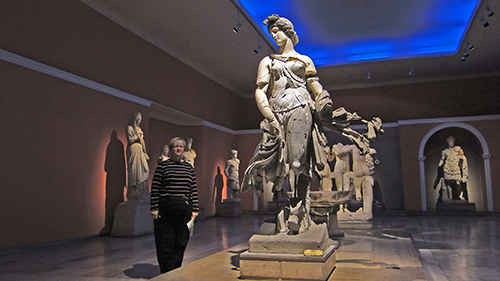
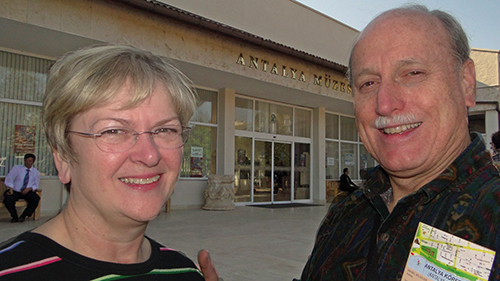
Tuvana Hotel. We finished the museum and head back to the bumper problem out in the parking lot. Jerry worked on the bumper for a while and got the main piece popped back into place pretty good. He thinks the bumper will stay in place. We are off to find a car wash in this teeming city, since the car is still muddy from the visit to the Lystra tel out in the countryside. We found a car wash pretty easily, thankfully, and got the car cleaned up.
We then start trying to find our hotel, which proves impossible. The traffic is horrendous, the streets are blocked, etc. I don’t know how Jerry stood the mayhem. Lines for lanes and stoplights for intersections are only suggestions as far as Turkish drivers are concerned. They drive like bumper cars at the fair. I’m doing no better trying to orient us with the map and the Garmin. What do the Turks have against street signs?
After an hour of useless turning round and round the same intersections, Jerry suggests we should stop and hail a cab to take me to the hotel so Jerry can follow. Finally, after a pretty long wait, I am able to get a cab. The trip to the hotel was unbelievable. Jerry thought he literally was going to loose both outside mirrors trying to negotiate what cannot be more than alleyways. What we learn later is that our hotel is right in the middle of old town in the ancient historical district, whose streets were not much more than walking paths originally. When we finally arrive at the hotel in this historic district, we realize in no way we ever would have found this hotel on our own.
The headache to find the hotel was worth the destination. The Tuvana Hotel is as charming as promised and more; since the tourist season has not really begun, our room is upgraded when we check in. The room is beautiful.
We have dinner at the hotel, which was very good food. Our only distraction from the wonderful restaurant atmosphere was a lady at a table nearby blowing her nose frequently and most loudly, not in any way making any attempt to be discrete about the process. That was disgusting. We are able to ignore her in the main and still enjoy our meal. After dinner, we sit outside in the swing of the enclosed patio garden area for a little bit. We decide we have had a good, but very stressful day, with the long drive through mountain passes coming out of Yalvaç down to the coast, tearing off the bumper at the museum, and fighting Antalya traffic in search of a hotel impossibly hidden down an unmarked alleyway. A shame we have plans to stay here only one night, as the arrangements are wonderful.
At the end of the day, Jerry, of course, goes right into his nightly ritual of setting up his “charging station.” He is quite the techie guy. How he keeps everything going is amazing.
Tomorrow we’ll walk down to the ancient harbor of Attalia (today’s Antalya) and then find Hadrian’s gate before leaving for the ancient site of Perge. [With the reservations she secured at the Tuvana Hotel right in the middle of Antalya’s historic district, Jean has placed us in one of our best accommodations of the trip, simultaneously putting us within walking distance of both the ancient harbor and Hadrian’s gate to boot, so, once again, she has demonstrated how well she has mastered the art of the travel itinerary—Jerry.]
For a video of the Yalvaç and Antalya action today:
